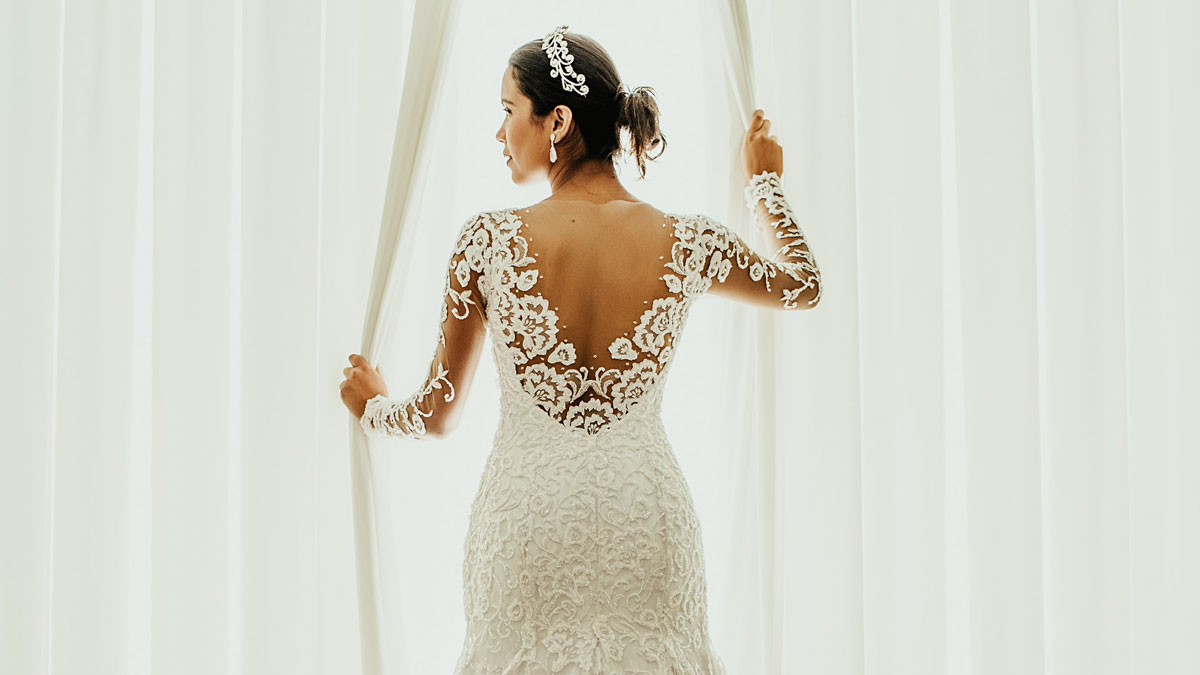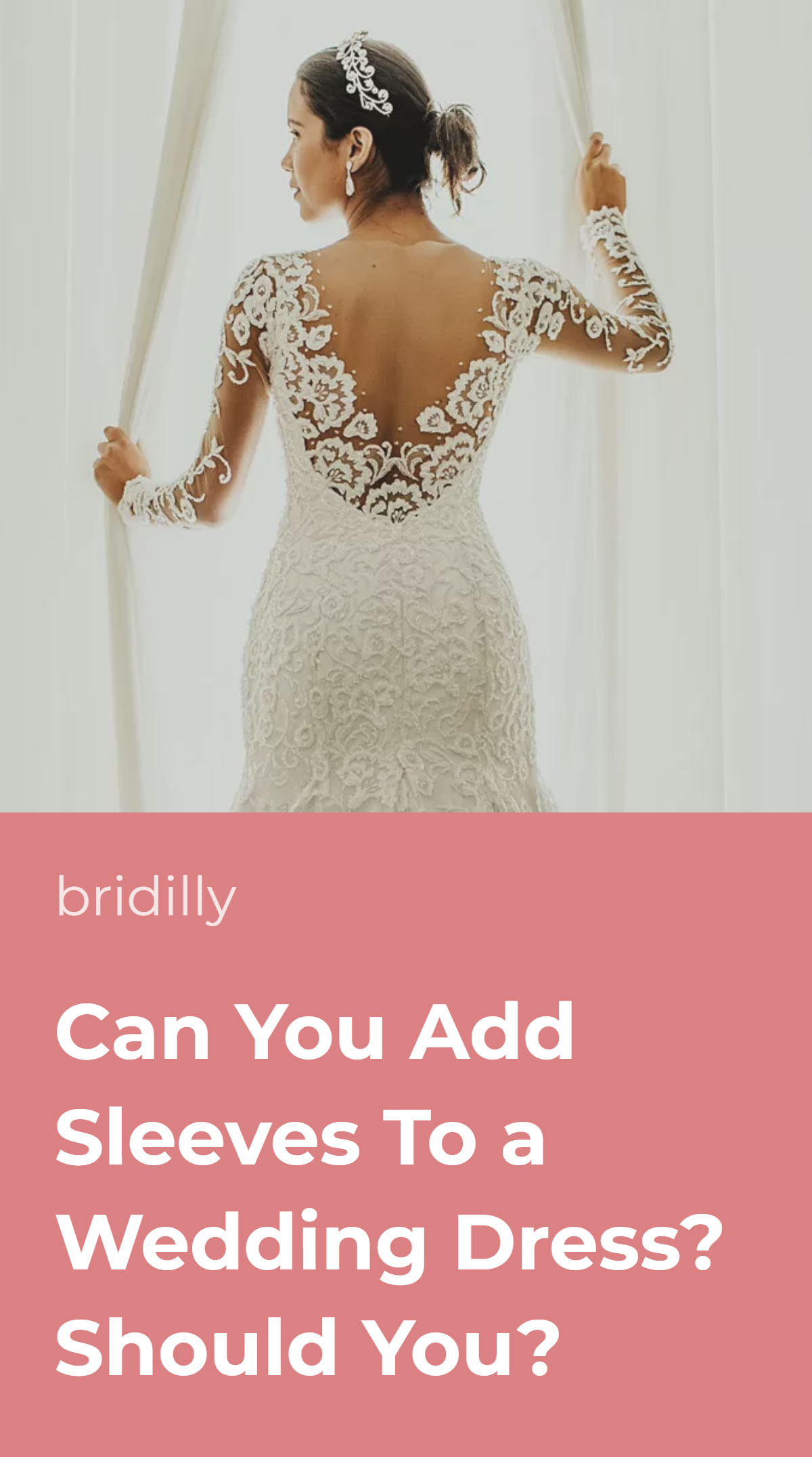Adding sleeves to a wedding dress is one of the most popular bespoke customization requests, and it’s no wonder.
Sometimes, such a seemingly minor detail can drastically change the dress’ look and add comfort.
Sleeves can serve as a practical element to prevent the dress from slipping or be a fashion statement, drawing all attention to the upper body.
Perhaps, it’s the most useful wedding dress alteration, adding arm coverage and keeping the bride warm in colder weather.
But despite all the benefits, brides wishing to add sleeves to their dress must also consider the drawbacks, including added costs and timeline changes.
Table of Contents [show]
Can You Add Sleeves to Any Dress?
A question many brides wonder when choosing a gown is – “can you add sleeves to any wedding dress?”. Sometimes, you seem to find the perfect dress, with the only drawback being the lack of sleeves.
The short answer is yes; you can add sleeves to virtually any dress regardless of the neckline style and material.
Although some cases are more complex than others, an experienced sewist can find a way to add sleeves to your gown.
Benefits of Adding Sleeves
Adding sleeves to a wedding dress has numerous practical benefits. Perhaps, the most apparent is that sleeves prevent your gown from slipping.
Brides who admire strapless dresses but don’t want to compromise comfort may consider adding spaghetti straps to their gown.
Furthermore, sleeves will keep you warm when evening arrives. Of course, it may be a drawback if your wedding is planned for a hot summer day, but detachable sleeves are always an option.
Sleeves also benefit brides concerned about bigger arms or broader shoulders. Added coverage boosts confidence, ensuring the bride looks and feels her best.
Apart from concealing arms, a correctly chosen sleeve style helps balance proportions. For example, balloon sleeves are excellent for brides wishing to balance wide hips.
After all, sleeves are simply beautiful. Intricately-designed sleeves draw attention to the upper body, which is excellent for brides who want to shift the focus from the lower body to the bust and waist.
Sleeves can make even the most basic wedding dress beyond gorgeous, converting it into a fashion statement piece.
Choosing the Sleeve Style
Choosing the sleeve design usually isn’t easy due to the array of beautiful styles. Consider your wedding style, body type, dress design, and the weather to pick the right option.
Off-the-shoulder is one of the most romantic, seductive wedding dress sleeve styles. They create an effect of mystery, exposing skin in a chic way.
While such sleeves won’t keep you warm or help to keep the dress in place, they are a beautiful design element. Off-the-shoulder sleeves are often embellished or made from luxurious lace.
Flutter sleeves are perfect for a feminine, whimsical bridal look, falling in folds over the shoulders. The sleeve length may vary from just below the shoulders to three-quarters.
Medium-length flutter sleeves are impeccably elegant, providing perfect coverage to fuller arms while letting the skin breathe.
Bell sleeves are characterized by full-length and wide cuff opening. Such sleeves can be fitted or loose at the top. Sometimes, bell sleeves have a dramatic flare and extreme length, making a fashion statement.
Flowy bell sleeves are common in boho wedding dresses and were favored by nobility in the Medieval Era and style icons of the 1970s. As opposed to bell sleeves, cap sleeves are a modest choice for brides preferring a dainty, chic look.
This style covers the shoulder but not the upper arm, ideal for brides wishing to keep their dress in place without perspiring or drawing too much attention to the arm area.
Illusion wedding dress sleeve style toes the narrow line between coverage and transparency, featuring a delicate semi-sheer tulle creating a naked skin effect and an intricate lace pattern.
Some illusion dresses have beading or sequin embellishments instead of lace.
This sleeve type is perfect for brides wishing to add a twist to their dress styling and keep the look seductive while adding coverage and preventing the dress from slipping. Illusion sleeves can be of any length, usually tightly-fitting.
Bishop sleeves is a style similar to bell sleeves but cuffed at the wrist. It’s a romantic style perfect for bohemian brides. Sometimes, bishop sleeves are off-the-shoulder.
Short, puffy sleeves cuffed at the bottom are known as balloon sleeves, a whimsical, dainty style. They perfectly balance wide hips.
Lastly, you may consider elegant, minimalist fitted long sleeves without lace, flaring, ruffles, and other indications.
Detachable Sleeves
Nearly any of the above-mentioned sleeve styles can be made detachable for added versatility.
Detachable sleeves enable the bride to adapt her outfit to the changing weather. Plus, they can convert a single dress into two distinctly different looks.
For instance, a column dress with off-the-shoulder bishop sleeves looks dreamy and romantic, ideal for a ceremony in bohemian style.
But if you remove the sleeves, leaving the gown strapless, it becomes seductive and elegant, giving off an entirely different feel.
It’s an excellent choice for brides concerned about their dress being too open for a church ceremony or wishing to make a show-stopping outfit change without paying double the price.
Depending on the sleeve and dress style, sleeves can be attached to the dress using small hooks or simply held in place with an elastic.
Professional or DIY
Adding sleeves to a wedding dress is undoubtedly easier than sewing an entire dress from scratch, but you should adequately evaluate your skills.
Most wedding gowns are made from delicate fabric with intricate décor and require extra-careful handling.
Attaching sleeves to a wedding dress often requires removing embellishments and hand-stitching because machine-stitching can damage some fabrics, such as natural silk.
Of course, brides experienced in sewing can go for DIY wedding dress sleeves.
However, if you aren’t sure about your skills, paying a professional sewist will help you avoid stress and ensure your dress looks flawless on your big day. It’s certainly worth the money. Plus, a pro can give you advice in complex cases.
The only styles that don’t require extensive sewing experience are spaghetti straps and detachable elastic sleeves. Spaghetti straps are easy to make even for beginners and usually don’t require any modifications to the dress.
Detachable wedding dress sleeves holding in place with an elastic band require a higher skill level, but since they don’t attach to the dress, you won’t damage it.
If something goes wrong, you can just start all over until you’re satisfied with the result.
Price Considerations
Price is a vital point for many brides considering adding sleeves to their wedding dresses.
Wedding dress alterations price is always higher than casual clothing alterations due to delicate fabric, design intrications, and extra attention needed for the work.
The price of adding sleeves to a wedding dress largely depends on the sleeve style and fabric.
Adding regular satin spaghetti straps may cost you about $60, and adding sophisticated illusion sleeves with luxurious lace and beading may cost well over $300.
Most brides pay $50-$250 for adding straps to their dresses. Naturally, no one would charge you $250 for ordinary straps – such a high price tag usually includes beading work and other decorative elements.
Meanwhile, the average cost of adding long sleeves to a wedding dress exceeds $300 and can easily reach $1,000 if you opt for expensive fabrics and an elaborate design.
Interestingly, making custom detachable sleeves is often cheaper than attaching them to the dress because the latter usually requires making changes to the dress neckline and shoulders and removing embellishments.
Sleeve Alteration Timeline
Even if your budget is unlimited, there are some vital points to consider apart from the sleeve style, such as the timeline. The wedding planning timeline tends to be tightly packed, so you should be sure you have enough time for alterations.
Yet again, it all depends on the sleeve style, intricacy, and fabric. If you want to add ordinary spaghetti straps without any embellishments, a week may be enough, provided that your sewist has a moderate workload.
On the other hand, adding long sleeves with an elaborate design may take multiple months.
Note that bespoke wedding dress alterations can change the entire dress fit – for instance, sleeves may affect the neckline look, and the sewist may have to make additional changes.
The problem is that you never know how sleeve alterations will affect the dress fit before they’re complete. Therefore, allow at least three months before the wedding for any major sleeve customizations.
Sleeve Alternatives
If you’re looking for extra arm coverage but don’t have the time or budget for bespoke customizations, consider wedding dress sleeve alternatives.
For instance, you may wear long gloves for an impeccably elegant and easily transformable look.
Another great alternative to sleeves is a capelet or bolero. It’s an excellent choice for fall and winter brides concerned about feeling cold.
The capelet or bolero can be made from delicate lace, velvet, fur, or any other material to fit your wedding style.

















No Comments Add one
Leave a Comment